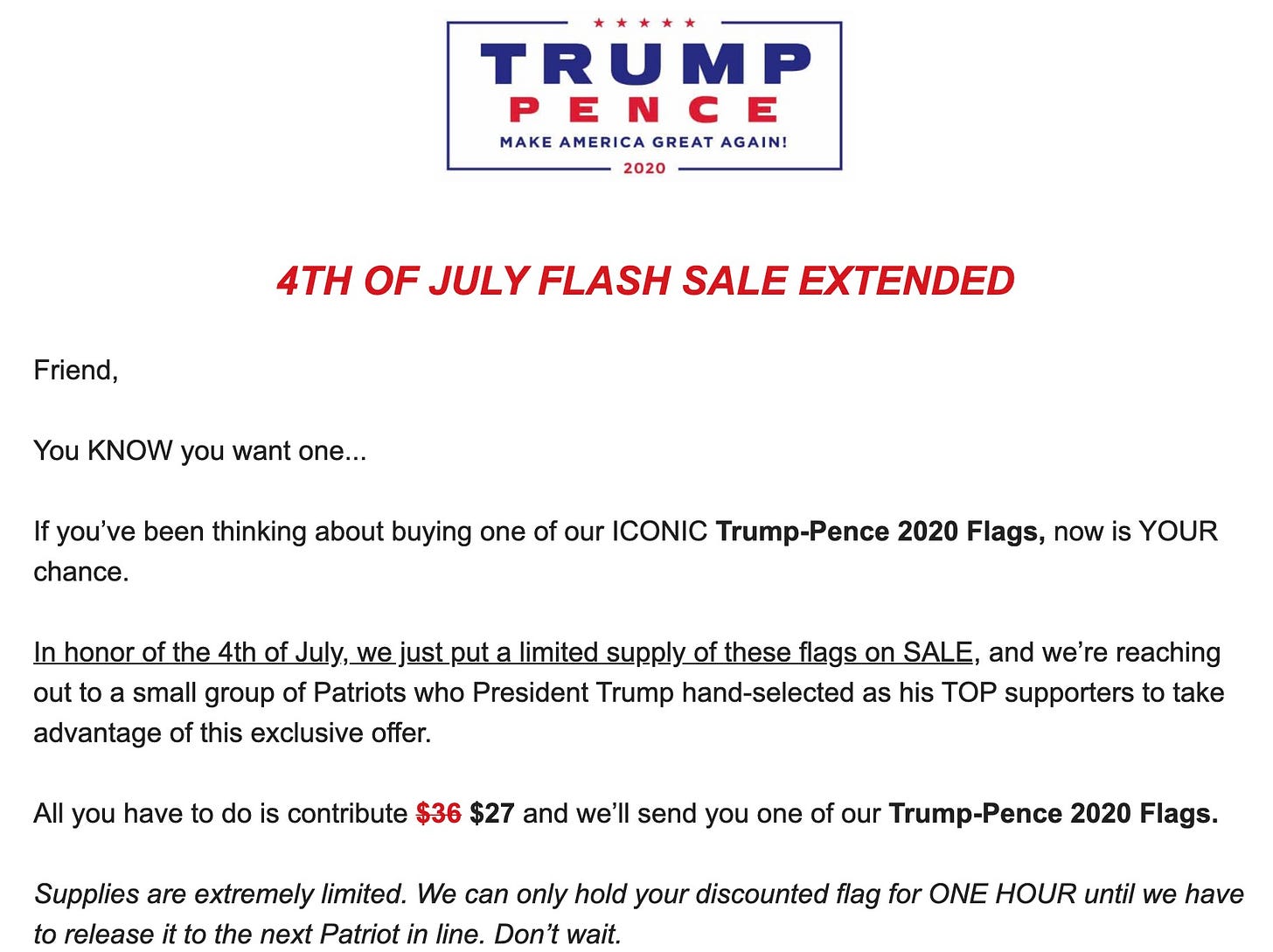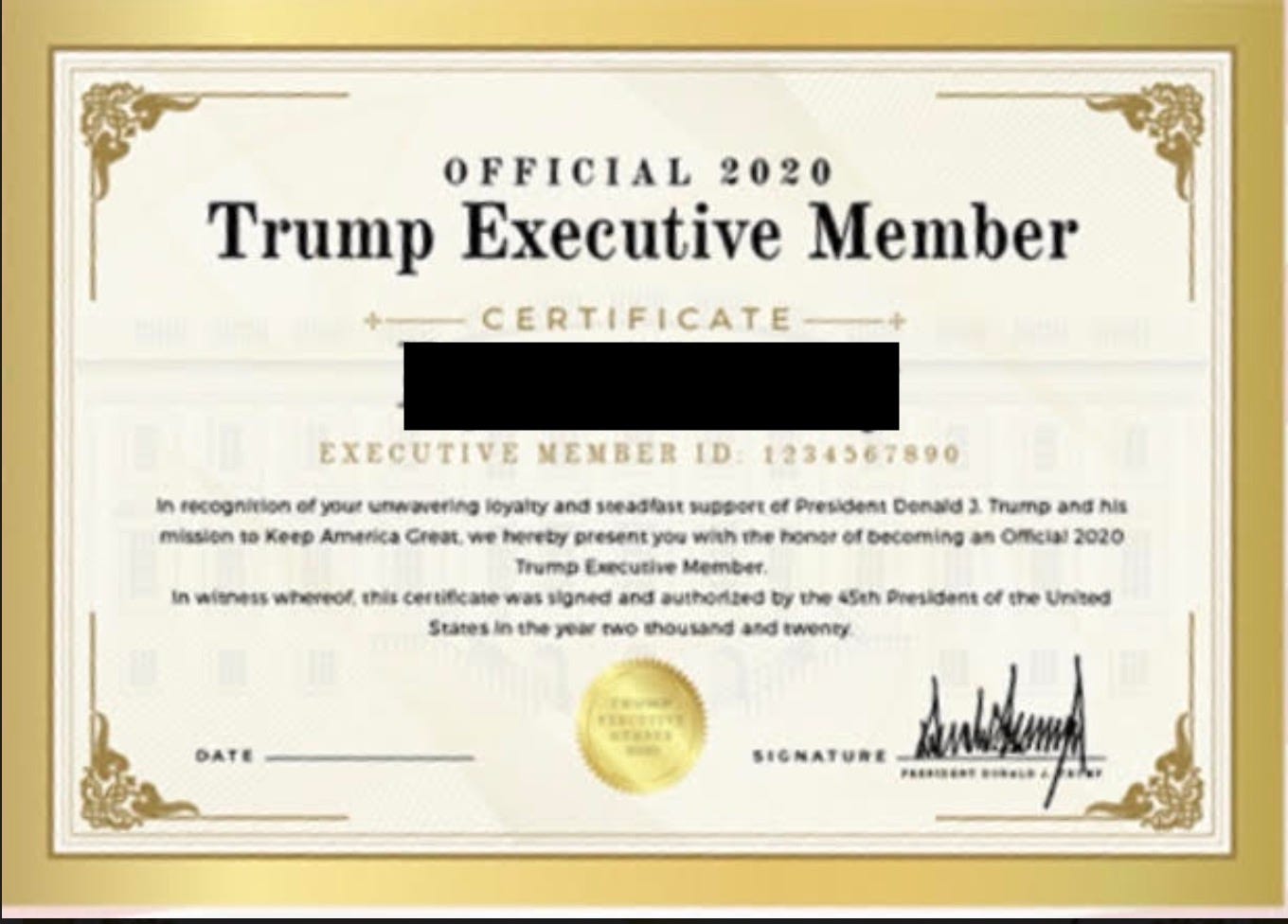The Trump Digital Operation Isn't Trying to Win the Election
It's using brute-force marketing to grow the installed user base for what comes next.

1. About that Death Star . . .
Over the weekend the vaunted Trump digital operation rolled out a pretty amazing ad on The Facebook:

You may recognize that statue. It's called "Christ the Redeemer." It's the most famous statue in Rio de Janeiro. Might be one of the 10 or 20 most famous statues in the world.
So when Trump's digital operation promises "We Will Protect This" under a picture of "Christ the Redeemer," either it means that the campaign thinks its supporters are idiots, or the campaign is so incompetent that they're making the president look like an idiot.
Except that there's a third possibility. Let me share two other Trump Digital ads which I saw over the last few days.
Here's an email that went out from the campaign on July 6 hawking a Trump 2020 flag:

So the Trump campaign only has a limited supply of these flags. The flags are going like hotcakes. Patriots are lined up around the block to get them.
. . . And the campaign is emailing supporters offering them at a discounted price.
I mean, if you took this sort of thing seriously, you'd think that these people were idiots. If you have a hot commodity you sell it for more money, not less. Otherwise Trump Patriots would be snapping these flags up at $27 a pop and flipping them on eBay for some sweet arbitrage.
But of course, a come-on like this isn't meant to be taken seriously. At least not by anyone with an IQ over 100.
Which brings us to the last ad I'm going to share with you:


You tell me: Does this look like a program designed to activate and persuade voters? Or does it look like a low-rent marketing scam?
2. What's the Endgame Here?
I know what you really want to know. What does the Official Member Certificate look like?

If you look close, you'll see that even though this email was being sent out in July, the Official Member Certificate is still using the abandoned Keep America Great campaign slogan.
Oops.
To a certain extent I'm goofing on Trump and Brad Parscale. A presidential campaign is a big operation. No one is really keeping track of every digital ad that goes out the door. And to a certain extent, these things are probably the campaign equivalent of those creepy YouTube kids videos that are created mostly by bots and watched mostly by bots—where algorithms are A-B testing and tweaking to infinity.
So just because these ads are so sloppy that they look like they came out of a fly-by-night Macedonian click-farm doesn't mean that the president of the United States is running the presidential campaign version of Trump University.
Unless it does I'm Ron Burgundy?
What strikes me about all of these ads—and I've shared others with you before—is that they go out of their way to pretend that they are personally and specifically tying the reader to Donald Trump.
Trump authorized this flash sale.
Trump hand-picked you to get this email.
Your name is being sent directly to Trump
Trump needs to hear the results of the survey you're filling out.
Trump picked your name out of millions to join an exclusive, 100-person club.
This isn't electioneering. It's grooming.
As Nicholas Grossman wrote yesterday, Trump is entering the Chapter 11 phase of his presidency where the walls are closing in on him and he stops trying to win the election and starts planning the next scheme while making sure that someone else is left with the bill.
My working theory is that Trump's ads are telling us what that next scheme is. He's tying himself more completely to the base of his base so that he can integrate them into Trump TV or Trumpstagram or whatever venture he's planning for January 21, 2021.
After all, he's got an installed user base of probably 30 million people he can start milking the minute he's out of office. That puts him halfway to Disney Plus. At say, $9.95 a month, you're talking about very real money.
You can't win a national election with 30 million people, but you can control a political party with them. And you can make some pretty serious money with from them while you do it.
3. Being Charlie Kaufman
I have a great deal of sympathy for Jon Mooallem for having to figure out a way to write this piece. And yet.
“So they required rewrites?” Charlie Kaufman asked.
Yes, I explained. I’d just received some discouraging feedback from the editors of this magazine about a draft of a story I turned in two weeks earlier. The story was a profile of him: Charlie Kaufman, the 61-year-old Oscar-winning screenwriter, known for films so rich with surreality and self-referential lunacy that they feel as if they might be spun apart by the force of their strangeness, yet miraculously cohere. (He first made his name in 1999 with “Being John Malkovich,” about a morose, avant-garde puppeteer who takes a temp job on the seventh-and-a-half floor of a Manhattan office building and discovers a dumbwaiter-shaped portal into the actor John Malkovich’s brain.) The occasion for the profile was the publication, on July 7, of Kaufman’s first novel, “Antkind,” a book that’s a half-foot thick and absolutely synopsis-resistant.
Our initial plan had been for me to fly to New York to interview him one Wednesday in March, but that plan evaporated when the nation’s first coronavirus outbreak started flaring near my home in Washington State. Instead, as I explained in my first draft of the story . . . And at this point, Mooallem goes and blockquotes a large section of the rejected first draft of his piece. In the published piece. Read the whole thing?


